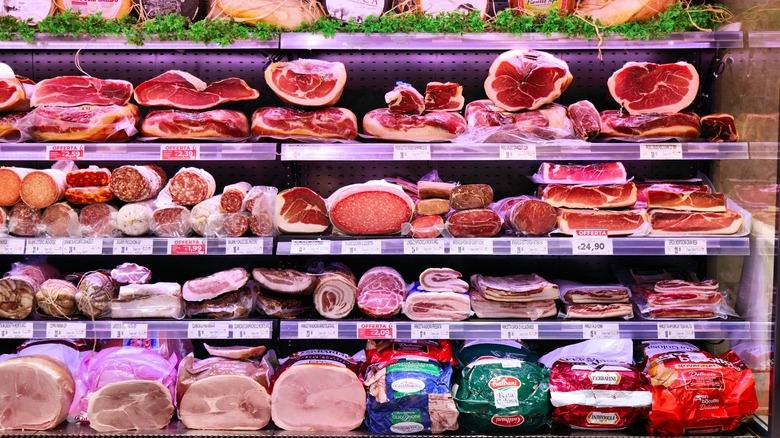The Reason There Are Rainbow Spots On Your Deli Meat
Have you ever ordered a freshly cut batch of deli meat, only to return from the store and find that it looks spoiled and iridescent? With a rainbow-like sheen, your ham or roast beef might appear anything but fresh. However, this colorful change has nothing to do with your deli meat's safety; it's all about how the human eye perceives color.
Muscle proteins in meat are made of bundled strands. These tight bundles create a repeating pattern in the meat, and when it is sliced, these grooves are exposed to the light. When white light bounces off this uneven surface, some spots reflect the light while others absorb it. This creates the colorful shimmer appearance to the human eye.
While this science lesson may be interesting, it's important to answer the big question you're wondering: Is my rainbow deli meat still good to eat? In short, yes! This change in appearance does not indicate food spoilage, meaning you don't have to worry about any off tastes or contracting food poisoning. If the colorful deli meat is too disconcerting, either cut off the shiny edge (if it's a large piece, such as roast beef) or, if it's slices for a sandwich, just cover it in your favorite condiment.
The science behind the rainbow shimmer
The phenomenon of iridescent rainbow deli items is found almost exclusively in cooked or cured meat varieties. This is due to their firmer texture, which, when cut, has a higher likelihood of showing off the muscle protein patterns that reflect and absorb white light, creating the colorful appearance.
The change more commonly appears on darker cuts of meat, such as roast beef or ham, thanks to their contrasting color. This rainbow hue is typically found only in whole muscle deli meats, instead of processed loaves such as turkey or bologna, where the protein fibers have been finely ground.
Besides the type of deli meat, how these products are cut can help determine whether they'll appear in a variety of colors. Meats sliced against the grain show iridescence due to the cut fibers that produce a small groove pattern for refraction. The final deciding factor is the sharpness of the deli counter's equipment. A very sharp slicing blade can result in a smoother surface on the meat, which is more likely to reflect rainbow iridescent colors because a flat facet shows the recurring pattern of protein grooves, while an overly rough surface from a blunt knife will not reflect enough light.
How to tell if your deli meat is safe to consume
While a rainbow appearance can be off-putting with deli meat, it's not a real indicator that it's spoiled. Color changes to look out for include hues of brown, light gray, or yellow. If this tint is happening around the edges of the meat, these are signs of spoilage. And what if your meat isn't rainbow? What if your bacon has a greenish hue? If the product is a cured meat, this green coloring could be due to preservatives, such as nitrites, reacting to the proteins.
Always check the texture of deli meat to ensure there's no stickiness or sliminess. A little moisture is fine, but if there's a film coating your fingers after touching it, then you can assume the meat has gone bad. This is an indicator that something like yeast or bacteria is growing on the deli meat. And if there are fuzzy spots or dots of mold, it's time to trash it.
You can always give your deli meat the old-school sniff test to suss out any strange odors. Be aware that scents like sourness or staleness are often signs it has spoiled. As long as the meat is before its expiration date, and after opening you haven't stored it for longer than three to five days at the correct temperature, it should be safe to eat. At the end of the day, the best rule is: If in doubt, throw it out.



